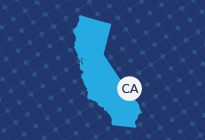How does San Diego Gas & Electric (SDG&E) net metering work?
San Diego Gas & Electric’s net metering program makes it possible for solar energy system owners who are connected to the grid to receive credit for their excess solar electricity. These credits can be used when your solar panel system isn’t producing enough power to meet the electricity demands for your home or business. However, SDG&E net metering isn’t a way to earn extra money – in order to qualify, your solar panel system must be sized to match your electricity needs, but no bigger.
Where does SDG&E offer net metering?
San Diego Gas & Electric offers net metering across its entire service territory, which includes all of San Diego County as well as southern Orange County.
What are SDG&E’s rates and prices for net metering?
The specific rates and pricing for net metering in San Diego Gas & Electric’s territory are currently determined based on your property’s electricity rate structure. However, the structure is simple: for each kilowatt-hour (kWh) you feed back to the grid, you get a credit on your bill for the full retail value of that kWh (e.g., the rate that you pay for a utility-generated kWh) minus a few cents per kWh for non-bypassable charges (NBCs), which are primarily environmental benefit programs that all SDG&E customers pay for and can’t avoid with solar.
The SDG&E net metering program saw some changes under net metering (NEM) 2.0, which began in June 2016. On April 15, 2023, SDG&E will switch to a new program, NEM 3.0 (also called the Net Billing tariff, or NBT), which will significantly change how net metering works. Instead of crediting you at the full retail rate, SDG&E will provide credits based on how valuable it is to not use electricity during a certain hour, or the “avoided cost rate”. Overall, this means the price that SDG&E will pay you for solar you send to the grid is set to drop by about 75%.
-
Credits for exported electricity
- Net metering 1.0 (before June 2016)
- Full retail rate
- Net metering 2.0 (starting June 2016)
- Full retail rate minus NBCs
- Net metering 3.0 (starting April 15, 2023)
- Avoided cost rate
-
Non-bypassable charges (NBCs)
- Net metering 1.0 (before June 2016)
- Paid for the net electricity consumed in a year (imports minus exports)
- Net metering 2.0 (starting June 2016)
- Paid for the net electricity consumed in a metered interval (one hour for residential customers)
- Net metering 3.0 (starting April 15, 2023)
- Paid for all electricity imports
-
System size regulations
- Net metering 1.0 (before June 2016)
- System must be no larger than customer’s electricity needs, and less than 1,000 kW
- Net metering 2.0 (starting June 2016)
- System must be no larger than customer’s electricity needs, but no restriction on size
- Net metering 3.0 (starting April 15, 2023)
- System can be up to 50% larger than customer’s electricity needs, if the customer attests to needing it in the future
-
Billing
- Net metering 1.0 (before June 2016)
- Annual billing, both charges and credits roll over for 12 months
- Net metering 2.0 (starting June 2016)
- Annual billing, both charges and credits roll over for 12 months
- Net metering 3.0 (starting April 15, 2023)
- Monthly billing, only credits roll over for 12 months
-
Interconnection fee
- Net metering 1.0 (before June 2016)
- None
- Net metering 2.0 (starting June 2016)
- $132 for systems under 1,000 kW
- Net metering 3.0 (starting April 15, 2023)
- $132 for systems under 1,000 kW
-
Electricity rate
- Net metering 1.0 (before June 2016)
- Standard
- Net metering 2.0 (starting June 2016)
- Time-of-use (variable based on time of day and season)
- Net metering 3.0 (starting April 15, 2023)
- Specific “electrification” time-of-use rates (variable based on time of day and season)
Under NEM 2.0, you’ll save about 60% more over 20 years compared to NEM 3.0 as a SDG&E customer. Luckily, you still have time to lock in NEM 2.0 rates for 20 years before NEM 3.0 takes effect! You just need to sign a contract with an installer and ensure they have enough time to submit the interconnection application by April 14, 2023. From there, you have three years to actually get your system installed. If you currently have solar, no need to worry – as long as you aren’t planning on adding any capacity to your system, you’ll remain on your current net metering plan for 20 years after your original interconnection date (at which point you’ll be switched to NEM 3.0).
Learn more about how to become grandfathered into NEM 2.0.
What is San Diego Gas & Electric’s net metering cap?
Under California’s original net metering policy, SDG&E had a net metering cap of 5% of total peak electricity demand in the utility’s territory. However, as of June 2016 there is no cap on net metering in SDG&E territory.
Is SDG&E net metering the best in California?
SDG&E’s net metering program is structured the same way as the two other largest utilities in the state, Pacific Gas & Electric and Southern California Edison. The economics of the net metering program for these three utilities will be very similar.
However, there are some other electric utilities (such as Los Angeles Department of Water & Power) in California that offer simpler net metering policies because they don’t require solar system owners to enroll in time-of-use (TOU) rates. Because SDG&E’s net metering program uses TOU rates, solar homeowners won’t always get the maximum value out of their solar electricity – grid electricity during the early to mid-afternoon hours will cost less, so the solar electricity sent back to the grid during those times will receive a lower net metering credit. That being said, a good solar installer can help you design a solar system that generates more power during the high-cost peak hours, reducing your monthly utility electricity needs.
What will happen to my excess SDG&E net metering bill credits?
If you install a solar panel system that is sized to meet your electricity needs for the entire year, there will be some months where your panels produce more electricity than you need and some months where your panels produce less.
When your panels produce more energy than you can use over the course of a month, you will receive bill credits on your SDG&E bill that can be used in future months. If your panels produce more electricity than you use over the course of twelve months, you are credited for the extra kilowatt-hours at the wholesale compensation price.
To set the value of the wholesale compensation price, SDG&E calculates a per-kilowatt hour value for each month based on electricity market prices. At the end of 12 months, you will receive a bill credit for any extra electricity at the average rate during that month.
Does San Diego Gas & Electric offer solar incentives?
SDG&E doesn’t offer solar incentives for every homeowner. However, the California Solar Initiative has two rebate programs that low-income households in SDG&E’s service territory can qualify for: the Single-Family Affordable Solar Housing (SASH) and Multi-Family Affordable Solar Housing (MASH) programs.
Low-income customers can also enroll in the California Alternate Rates for Energy (CARE) program, which allows them to receive a 30-35% discount on their electric bills or the Family Electric Rate Assistance Program (FERA), which offers an 18% discount on electric bills – under both programs, customers will receive net metering incentives to make their solar payback period shorter. Learn more about these and other California rebates & incentives with EnergySage’s California Solar Incentives guide.
SDG&E solar interconnection policies and costs
The last step to have your solar panels connected to the grid is to submit an interconnection request, which your solar installer will often do on your behalf. The interconnection request ensures that SDG&E is aware that your property has a solar power system and that your system is safe to operate. Under NEM 2.0 and NEM 3.0, the interconnection request fee is $132 for SDG&E customers.
Looking for the best solar companies in San Diego Gas & Electric (SDG&E) territory?
You wouldn’t buy a car without comparing a few options first.Shouldn’t solar be the same?
Compare multiple solar quotes on EnergySage
With EnergySage, you can compare your solar options when you
receive quotes from the best local solar installers near you.
Get a quick estimate of your savings with solar
Find out how affordable solar is for your home with our Solar Calculator, or simply register your property today to get quotes.








